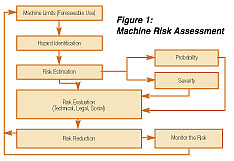
Finding guidance
In the U.S., there are a number of sources of guidance in how to safeguard industrial equipment adequately. OSHA issues requirements for protecting the point of operation (OSHA 1910.217(c) Safeguarding the Point of Operation).Voluntary consensus standards groups such as ANSI (American National Standards Institute) produce standards for machine safeguarding. Trade associations such as the Association of Manufacturing Technology (AMT), National Fire Protection Association (NFPA) and National Electrical Manufacturers Association (NEMA) form committees to develop these voluntary standards.
We live in a global economy. Increasingly, U.S. factories are using European standards when developing corporate requirements for machine safety. U.S. and European standards have increasingly become more like each other with minor differences. There is a growing trend toward ISO (International Organization for Standardization) standards.
Many companies have developed their own corporate safety guidelines for machine safety. Such guidelines give plant safety and facility engineers direction on what is expected when buying new equipment and can be used for upgrading the safety features of older equipment. They also provide companies with factories around the world the ability to have a consistent level of safety in countries that may not have the same requirements as the United States or Europe.

Machine risk assessment
Another method of determining what kinds of safety measures are needed is the use of risk assessment (Figure 1). The objective is to provide a level of safety consistent with the risk. For higher risks, more safety measures are needed. For lower risks, simpler counter-measures may be acceptable.How do we assess risk? ANSI B11.TR3-2000 Risk Assessment and Risk Reduction – A Guide to Estimate, Evaluate and Reduce Risks Associated with Machine Tools and EN (European Norm) 1050, Principles of Risk Assessment provide the “how-to†for doing a risk assessment of machinery.
Five key principles are involved:
1) Machine limits — The assessment starts by assessing the limits of the machine. What does the machine do and how? What are all the ways it is used?
2) Hazard identification — Next, identify reasonable foreseeable hazards, uses and users. Do this for the entire life-cycle of the machine, from installation, use, servicing and upgrading, to disposal.
3) Risk estimation — Once you know the types of hazards and the ways that the hazards can cause injury, you can estimate the risk. Risk is the combination of how often the injury occurs and the severity of the injury.
4) Risk reduction — If the risk is too high, corrective measures are in order. Use a “hierarchy of corrective measures†(Figure 2). You reduce the risk by design, then further reduce the risk through the use of safety devices, warnings and training. Design choices include: fixed guards with special fasteners; barrier guards or guard doors equipped with safety-rated devices; safety-rated light curtains; safety light beams; safety edges; and safety mats. You can also separate the operator by distance, railing or barrier to prevent access to the danger point.
5) Monitor the risk — Protecting the machine is not the end of machine safeguarding. You need to institute and enforce a culture of machine safety. Eliminate operators bypassing safety devices. Train operators and maintenance personnel on safe behavior. This includes establishing and enforcing a code of conduct for operating and working around hazardous machinery.
NOTE: Figures 1 & 2 are copyright of Lewis Bass International, Inc., 2005.
